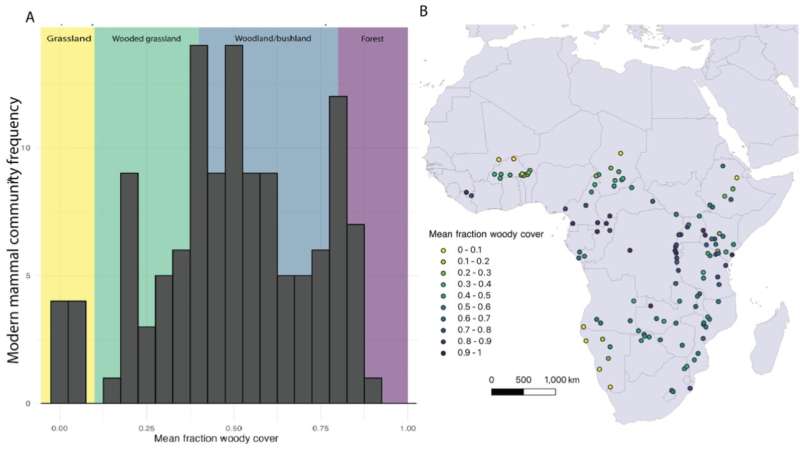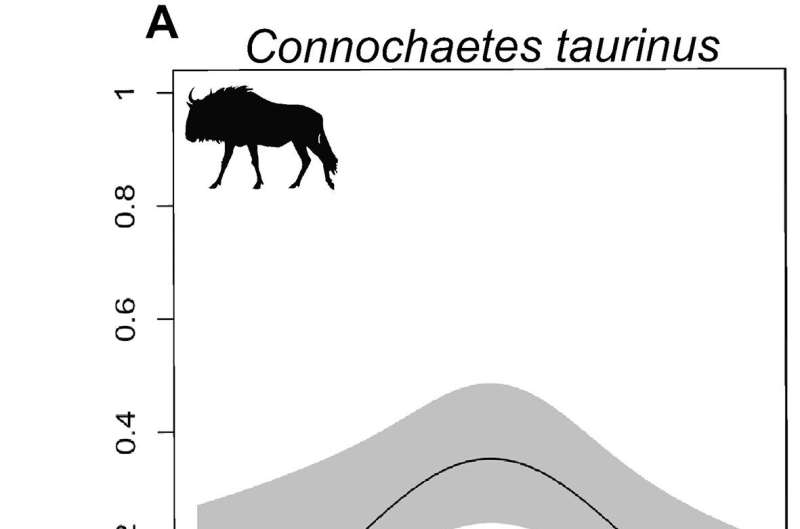September 19, 2023 feature
This article has been reviewed according to Science X's editorial process and policies. Editors have highlighted the following attributes while ensuring the content's credibility:
fact-checked
peer-reviewed publication
trusted source
proofread
Grassland expansion was not a main driver of mammal evolution in Plio-Pleistocene Africa, research suggests

Mammal evolution in Africa, including that of modern human ancestors, through the late Cenozoic (Plio-Pleistocene, ~5.3 million years ago) may not have been driven by the expansion of grasslands as previously thought, new research has suggested.
Changes in vegetation would likely have impacted the spatial range of mammal groups as they adapted to the environment, while extreme cases may have led to extinctions and the origination of new species. The extent to which vegetation needed to change to elicit such significant responses is the focus of research by Kathryn Sokolowski, a graduate researcher at the University of Utah, and colleagues.
The research team turned to modeling 58 modern herbivorous species and assessed their responses to changes in woody cover from trees and shrubs across 123 parks and nature reserves throughout Africa. This was based upon presence/absence data of species (including cheetahs, impala, hartebeest, squirrels, wildebeest, otters, porcupine, mongoose, jackals, zebra, monkeys, wildcats, bushbabies, giraffes and hippos) and used satellites to measure vegetation cover.
Specifically, the study also reflected mammal dietary preferences from grazers (eating mostly grasses and herbaceous plants), browsers (eating leaves and twigs of trees, shrubs and herbs, plus some wild fruits), frugivores (eating fruits, nuts and seeds, plus plant roots and shoots) and mixed feeders (eating a combination of the aforementioned).
The results, published in Palaeogeography, Palaeoclimatology, Palaeoecology, reveal a preference for environments with approximately half woody (tree and shrub) cover, measured as 0.5 mean fraction woody cover (fwc), representing the area of trees and shrubs relative to grasses, herbaceous vegetation and unvegetated areas. Very few species preferred open (<0.3 fwc, with grasslands being <0.1 fwc) and closed (>0.7 fwc, with forest being >0.8 fwc) landscapes.
The measurements do not take into account the precise height of vegetation and homogenizes certain types, for example combining woodland with bushland and grassland with deserts over scales of 100–1,000km2. However, Sokolowski and colleagues are able to discern that the expansion of grasslands through the late Cenozoic may not have been a significant factor impacting mammal speciation and extinction in Africa.
Only four species of gemsbok, springbok, red-fronted gazelle and mountain zebra expressed a distinct preference for open habit in the models, with the probability of decline as woody cover increases highly likely. Conversely, 11 species exhibited a probability of occurrence decline with a shift to open grassland from closed woodland, these including duikers and some antelope.
Meanwhile, 21 species modeled within the middle ground of grassland and woodland cover (0.4–0.6 fwc), including impala, buffalo and wildebeest, and 22 exhibited no sensitivity to changing vegetation cover, such as warthogs and bush elephants. Dietary preference also played a role for frugivorous species, which peak within areas of high woodland cover, though browsers, grazers and mixed feeders seemed to prefer mixed grassland and woodland environments.

Considering grazers, browsers and mixed feeders predominate in the unimodal range of both grassland and woodland, the research team conclude that savannah ecosystems are the most likely ecosystem to have proliferated in the late Cenozoic, with grass carpeting a large proportion of the landscape, interspersed by shrubs and trees.
Such environments were likely highly susceptible to annual precipitation, which could shift the vegetation either towards more arid conditions that would reduce growth productivity to support large herbivores requiring large quantities of food, while too much rain could dilute the plant nutrients to support smaller mammals requiring less but higher quality food. This therefore explains the absence of grazers in open grassland (<0.2 fwc) and browsers from forested woodland (>0.8 fwc).
Linking the modern communities to paleontological studies, Sokolowski and coworkers suggest that fossil remains are only likely to document a snapshot of the community averaged over a large area, and cannot be fully relied upon to reconstruct past landscape changes. For example, previous work on fossils has suggested that bushpigs are indicative of dense woodland, but the results of this new research averaged over a much larger area show that they are insensitive to woodland cover.
Consequently, the research urges caution when using certain fossils as "indicator species" during paleoecological reconstructions of mosaic habitats.
More information: Kathryn G. Sokolowski et al, Do grazers equal grasslands? Strengthening paleoenvironmental inferences through analysis of present-day African mammals, Palaeogeography, Palaeoclimatology, Palaeoecology (2023). DOI: 10.1016/j.palaeo.2023.111786
Journal information: Palaeogeography, Palaeoclimatology, Palaeoecology
© 2023 Science X Network





















